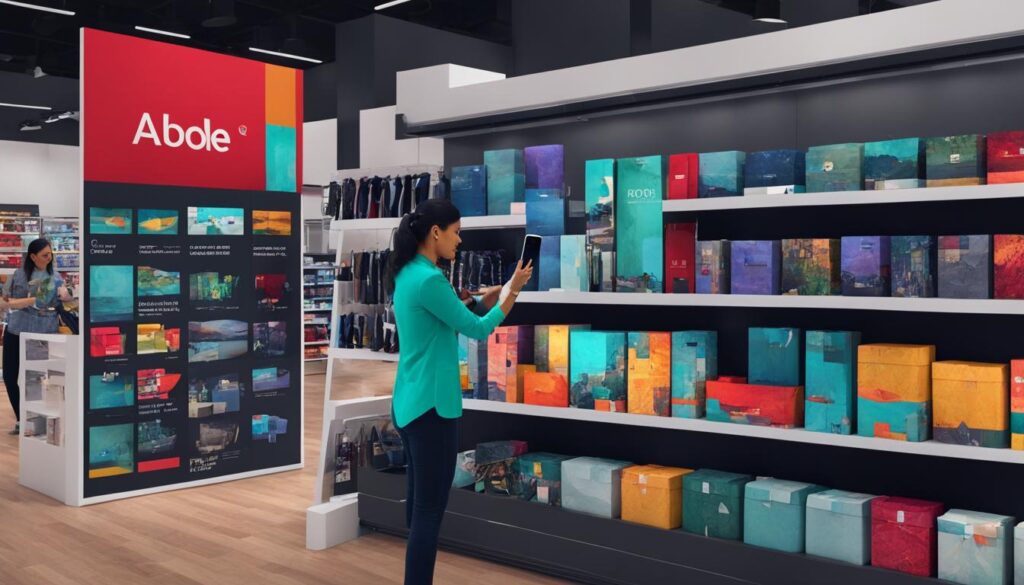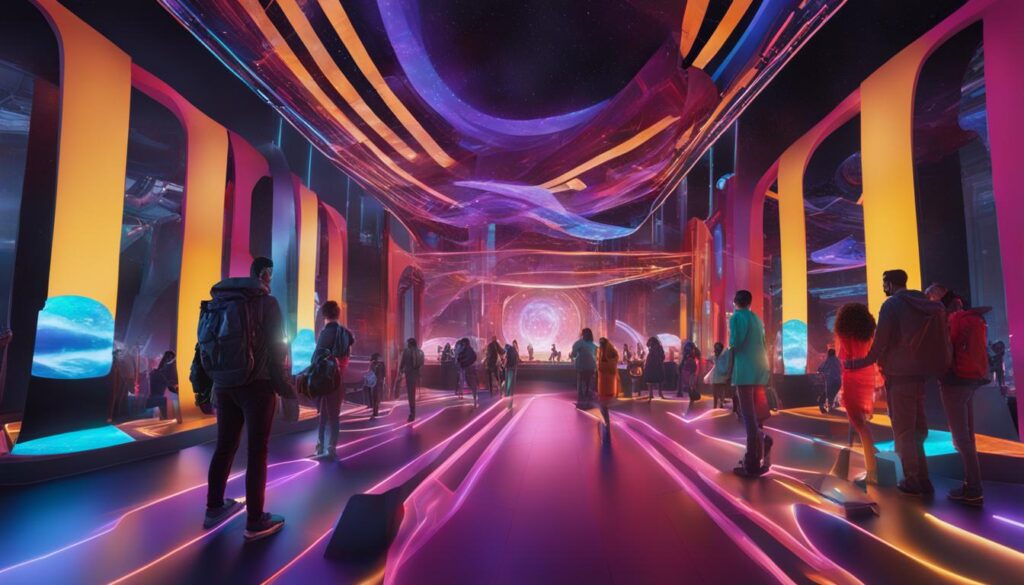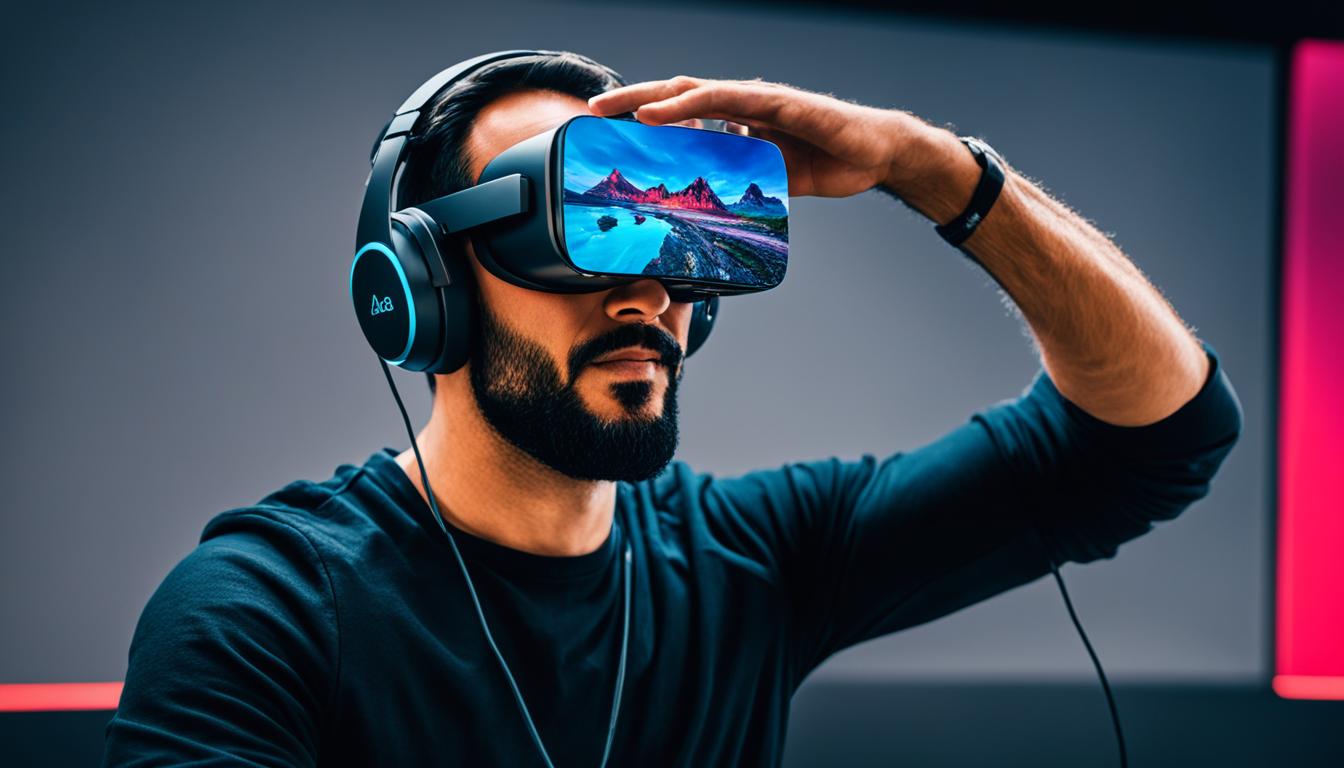Welcome to the exciting world of augmented reality (AR) and the endless possibilities it holds for businesses in the metaverse. In this article, we will explore how Adobe’s powerful suite of software and tools can empower you to create immersive experiences that captivate your audience and drive success in the digital realm.
As the metaverse continues to evolve, it is crucial for brands to prepare and leverage the opportunities it presents. With Adobe, you can integrate their industry-leading software into your AR projects, unlocking a whole new level of creativity and engagement. Whether you are developing dynamic 3D content or crafting immersive marketing experiences, Adobe has the solutions you need.
By collaborating with innovative brands like Coca-Cola and Epic Games, Adobe is at the forefront of 3D content creation and immersive experiences. Their expertise and tools have already proven to be invaluable assets for businesses looking to thrive in the metaverse.
One of the key advantages of using Adobe in AR is the seamless integration between their various software and tools. Whether you are using Adobe Aero for intuitive 3D AR experiences or Adobe Experience Manager for personalized content delivery, Adobe’s ecosystem streamlines your workflow and empowers you to create impactful experiences.
The benefits of leveraging Adobe in AR are abundant. Not only can Adobe’s powerful software enhance your customer experiences and increase engagement, but it can also save you time and resources. With Adobe’s intuitive design interfaces and robust rendering capabilities, you can create stunning visuals and memorable brand experiences without the need for extensive coding or development.
So, if you are ready to take your AR projects to the next level and unlock the true potential of the metaverse, look no further than Adobe. With their comprehensive solutions and commitment to openness and accessibility, Adobe is your ideal partner in navigating the ever-expanding world of augmented reality.
Contents
- 1 Augmented Reality: An Integral Part of the Metaverse
- 2 Enhancing Retail Experiences with Adobe Aero Geospatial Pre-release
- 3 The Power of Adobe Aero in Augmented Reality Marketing
- 4 Transforming In-Person Retail with Rock Paper Reality, Google, and Adobe
- 5 The Benefits of Adobe’s Powerful Software in XR Experiences
- 6 Conclusion
- 7 FAQ
- 7.1 Do I need to use Adobe for augmented reality (AR)?
- 7.2 How can Adobe be integrated into augmented reality (AR) development?
- 7.3 What are the benefits of using Adobe in augmented reality (AR)?
- 7.4 How can Adobe Aero be used in augmented reality (AR) marketing?
- 7.5 Can augmented reality (AR) be integrated into retail and marketing strategies?
- 7.6 How is Adobe collaborating with other companies in AR development?
- 7.7 What is the role of augmented reality (AR) in the metaverse?
- 7.8 How does Adobe Aero contribute to augmented reality (AR) in the metaverse?
- 7.9 How does Adobe Aero Geospatial Pre-release enhance retail experiences?
- 7.10 What is the significance of Adobe’s commitment to an open and accessible metaverse?
- 7.11 How can Adobe software benefit immersive XR experiences?
- 8 Source Links
Key Takeaways:
- Integrating Adobe into augmented reality projects can enhance customer experiences and increase engagement
- Adobe offers powerful software and tools, such as Adobe Aero and Experience Manager, for creating immersive AR content
- Collaborations with brands like Coca-Cola and Epic Games demonstrate Adobe’s leadership in the 3D content creation space
- Using Adobe in AR can streamline workflows and save time and resources for businesses
- Adobe’s commitment to openness and accessibility ensures that creators from diverse backgrounds can thrive in the metaverse
Augmented Reality: An Integral Part of the Metaverse
Augmented Reality (AR) is an essential component of the metaverse, playing a crucial role in enhancing user experiences within the real world through digital overlays. With the rise of immersive digital worlds, integrating AR into digital strategies becomes increasingly vital for businesses. Adobe Aero, an intuitive platform, enables the creation of 3D AR experiences on mobile devices, facilitating seamless interactions between virtual and real environments.
One remarkable example of AR’s potential in the metaverse is the collaboration between Adobe Aero and the Smithsonian Institution. Using Adobe Aero, the Smithsonian Institution developed captivating AR 3D Coral Reef exhibitions, immersing visitors in a virtual underwater world. Companies like Epic Games have also successfully incorporated AR into popular gaming experiences like Fortnite, effectively blurring the lines between virtual and physical realms.
As the metaverse continues to gain momentum, businesses must recognize the significant impact of AR on customer engagement and immersive digital experiences. By leveraging AR in digital strategies, brands can provide unique and memorable shopping experiences, creating a competitive edge in the metaverse. From virtual try-ons to interactive product demonstrations, AR enables customers to engage with products and brands in unprecedented ways.
Integrating AR into the metaverse takes customer experiences to the next level. Imagine virtually placing furniture in your home before buying it online or trying on clothes without stepping foot inside a physical store. AR in the metaverse makes these possibilities a reality, revolutionizing the way we shop and interact with brands.
Adobe Aero’s user-friendly interface and extensive capabilities make it an invaluable tool for businesses looking to harness the power of AR in the metaverse. The platform allows for the creation of immersive retail experiences, where users can visualize products in their environment, removing the barriers between online and offline shopping. From virtual showrooms to interactive product demonstrations, Adobe Aero empowers businesses to craft engaging and visually stunning AR experiences that captivate audiences.
Benefits of Augmented Reality in the Metaverse:
- Enhanced user experiences and interactions in the real world through digital overlays
- Seamless integration of AR into digital strategies for increased customer engagement
- Unique and immersive shopping experiences for customers in the metaverse
- Unprecedented opportunities for brands to showcase products and services
- Strategic advantage in an evolving digital landscape
As the metaverse takes shape, the role of AR becomes even more prominent, offering endless possibilities for businesses to connect with their customers and create unforgettable brand experiences. By leveraging Adobe Aero and embracing augmented reality, companies can position themselves at the forefront of the metaverse, setting the stage for future success in this immersive digital realm.
Enhancing Retail Experiences with Adobe Aero Geospatial Pre-release
In today’s digital age, retailers are constantly seeking innovative ways to engage customers and create immersive experiences. With the emergence of augmented reality (AR), businesses can now elevate their retail strategies to new heights. Adobe Aero, in collaboration with Google’s ARCore, introduces the groundbreaking Geospatial Pre-release, which revolutionizes geolocation capabilities in AR.
The Adobe Aero Geospatial Pre-release allows retailers to seamlessly merge the digital and physical worlds by creating 3D AR experiences connected to real-world locations. Through the simple scan of a QR code, customers can access immersive AR content on supported devices, instantly transporting them to a captivating retail environment.
This Geospatial Pre-release empowers retailers to enhance audience engagement by providing personalized experiences tailored to specific locations. By leveraging the power of geolocation, retail businesses can create unique and memorable interactions with customers, increasing brand loyalty and driving sales.
Imagine a customer walking down a busy shopping street, scanning a QR code outside a store. In an instant, they are transported into a virtual fitting room, where they can try on different outfits without physically stepping foot in the store. This level of immersion and convenience not only sets the brand apart from competitors but also establishes a deeper connection with customers.
This collaboration between Adobe Aero and Google’s ARCore opens up a myriad of possibilities for retailers looking to incorporate AR into their retail strategy. From interactive product displays to virtual try-on experiences, the potential for creating immersive retail environments is limitless.
Engagement through Location-Based AR
One of the key advantages of the Adobe Aero Geospatial Pre-release is the ability to engage customers through location-based AR experiences. Retailers can leverage specific locations to deliver targeted and contextually relevant content to customers. For example, a coffee shop could offer an AR experience that showcases the origins of their beans when customers scan a QR code on their coffee cups.
The seamless integration of AR into retail spaces not only enhances the customer experience but also provides valuable data and insights for retailers. By analyzing customer interactions with the AR content, retailers can gain a deeper understanding of customer preferences and behaviors, enabling them to tailor their offerings and marketing strategies more effectively.
Real-World Examples: Gap x Barbie Collection
The power of the Adobe Aero Geospatial Pre-release has already attracted the attention of major retailers. Gap and Mattel recently partnered to bring the Gap x Barbie collection to life through a location-based Aero AR experience. Customers visiting select Gap stores can scan a QR code and instantly immerse themselves in a virtual world where they can interact with digital Barbie dolls showcasing the latest collection.
| Retailer | Product | Experience |
|---|---|---|
| Gap | Gap x Barbie Collection | Location-based AR experience where customers can interact with 3D Barbie dolls showcasing the latest collection |
This collaboration demonstrates the power of AR in retail and highlights the immense potential for retailers to create captivating and immersive experiences for their customers.
With the Adobe Aero Geospatial Pre-release, retailers can unlock a new dimension of retail experiences, blending the physical and digital worlds to create truly unforgettable customer interactions. By incorporating AR into their retail strategy, businesses can stay ahead of the curve and provide customers with engaging and personalized experiences that drive brand loyalty and sales.

The Power of Adobe Aero in Augmented Reality Marketing
When it comes to augmented reality marketing, Adobe Aero is a powerful tool that can take your brand experiences to the next level. By leveraging AR technology, businesses can create immersive marketing experiences that captivate and engage their audience.
With Adobe Aero, you have the ability to create personalized and impactful AR marketing content. This allows you to connect with your audience on a deeper level and deliver experiences that are tailored to their interests and preferences.
One of the key advantages of using Adobe Aero is the ability to overlay AR content onto the physical world. By doing so, you can extend the reach and effectiveness of your marketing efforts. Imagine being able to showcase your products in 3D AR right in the customer’s environment, allowing them to visualize and interact with your offerings in a more immersive way.
Another benefit of leveraging AR in marketing is the flexibility it offers. With Adobe Aero, you can quickly make modifications and refresh your AR content, ensuring that your experiences stay fresh, relevant, and engaging. This agility allows you to adapt to changing market trends and customer preferences, keeping your brand at the forefront of innovation.
Adobe Experience Manager further enhances the power of Adobe Aero by enabling businesses to store and deliver personalized AR experiences across various digital media. Whether it’s through social media, websites, or mobile apps, you can provide consistent and compelling AR experiences that make a lasting impression on your audience.
Research has shown that AR retail experiences can significantly increase customer engagement and drive foot traffic. By leveraging the immersive nature of AR, you can create memorable brand experiences that leave a lasting impact. Whether it’s showcasing your products in 3D or offering interactive storytelling experiences, AR marketing with Adobe Aero allows you to stand out from the competition and create unique connections with your customers.
| Benefits of Adobe Aero in Augmented Reality Marketing |
|---|
| Enhances customer engagement |
| Delivers personalized and impactful content |
| Allows for quick modifications and content refreshes |
| Enables the creation of immersive brand experiences |
| Increased foot traffic and customer retention |
“AR marketing with Adobe Aero allows brands to create personalized, immersive experiences that captivate their audience and drive meaningful engagement.”
In today’s competitive market, leveraging augmented reality for marketing is more important than ever. With Adobe Aero, you have the tools to create memorable brand experiences that go beyond traditional marketing methods. Take advantage of the power of AR and Adobe Aero to connect with your audience in new and exciting ways.

Transforming In-Person Retail with Rock Paper Reality, Google, and Adobe
Rock Paper Reality (RPR), in collaboration with Google and Adobe, is revolutionizing in-person retail experiences through the integration of augmented reality (AR). By leveraging the power of Adobe Aero and Google’s Geospatial Creator, RPR is showcasing the tremendous potential of immersive customer interactions in the retail space.
One remarkable example is Paper Tree, a popular origami shop located in San Francisco, which partnered with RPR to create a location-based AR experience using Google’s ARCore and Adobe Aero. This innovative collaboration resulted in an interactive and visually captivating retail experience for customers. By scanning a QR code, users can view and interact with 3D scenes, elevating their engagement and enjoyment during their time in the store. This transformative use of AR demonstrates its ability to drive customer engagement and enhance the overall retail experience.
The collaboration between Rock Paper Reality, Google, and Adobe exemplifies the potential of geospatial AR experiences in retail. By combining cutting-edge technology with creative design, these transformative retail experiences offer customers a unique and immersive journey within the physical store environment. Seamless integration of digital content with real-world locations enables retailers to deliver unparalleled customer interactions and create lasting memories.
Key Benefits of Transformative Retail Experiences with AR
- Enhanced customer engagement through interactive 3D scenes and overlays
- Personalized and memorable retail experiences
- Innovative integration of digital and physical retail spaces
- Increased foot traffic and customer retention
- Unleashing creative storytelling and branding opportunities
- Opportunities for virtual try-on and product visualization
With the continued advancement of AR technology, the possibilities for transforming in-person retail experiences are vast. By embracing collaboration between industry leaders like Rock Paper Reality, Google, and Adobe, retailers can unlock the full potential of AR and create extraordinary customer interactions.
The Benefits of Adobe’s Powerful Software in XR Experiences
Adobe’s commitment to innovation and user-friendly software has positioned it as a leader in the XR (Extended Reality) industry. With a suite of powerful tools and solutions, Adobe empowers creators, designers, and businesses to harness the full potential of XR technology.
One notable software offered by Adobe is Adobe Substance 3D. This powerful tool allows users to create realistic and impactful texturing for XR experiences. With Substance 3D, you can add textures, patterns, and effects to 3D objects, elevating the visual appeal and authenticity of your XR projects.
Another key tool in Adobe’s arsenal is Adobe Aero. Designed specifically for XR content creation, Aero enables users to build immersive experiences seamlessly. With its intuitive design workflows, you can easily place 3D objects, animations, and interactions in real-world environments. Adobe Aero empowers you to create engaging XR experiences without the need for extensive coding knowledge.
By leveraging Adobe Aero for XR projects, you can unlock a world of possibilities. Whether you’re developing interactive product showcases, virtual tours, or educational experiences, Aero provides a user-friendly platform to bring your ideas to life.
“Adobe’s XR software, such as Substance 3D and Aero, offers unparalleled capabilities for creating immersive experiences. With these tools, you can transform concepts into captivating XR content, captivating your audience and driving engagement.”
Beyond the software itself, Adobe has made significant contributions to the development of XR technology. By championing open standards and collaboration, Adobe has fostered an environment of innovation and creativity. This commitment to democratizing XR development has helped shape the future of immersive experiences.
To further understand the impact of Adobe’s powerful software in XR, let’s take a look at a table showcasing the key features and benefits of both Adobe Substance 3D and Adobe Aero:
| Adobe Software | Key Features | Benefits |
|---|---|---|
| Substance 3D | Precise texturing capabilities | Enhance visual quality and realism of XR projects |
| Intuitive design workflows | Streamline the creation process and reduce time spent on development | |
| Seamless visualization of projects | Preview and iterate on XR content in real-time | |
| Aero | Easy placement of 3D objects, animations, and interactions | Create immersive XR experiences without coding |
| Intuitive design workflows | Bring XR concepts to life quickly and efficiently |
As seen in the table above, Adobe’s XR software provides creators with the necessary tools to deliver rich and engaging XR experiences. From precise texturing to seamless visualization, Adobe Substance 3D and Adobe Aero enable users to create XR content that captivates audiences and drives impact.
By leveraging Adobe’s powerful software, you can elevate your XR projects and unlock the full potential of immersive technologies. Whether you’re a designer, developer, or business owner, Adobe’s XR tools have something to offer for every stage of the XR content creation process. Embrace Adobe XR software and embark on a journey of immersive experiences that leave a lasting impression.

Stay tuned for the next section, where we’ll explore the exciting possibilities of leveraging Adobe’s powerful software in XR experiences.
Conclusion
In summary, the metaverse presents a promising future for digital interaction, and Adobe is at the forefront of leveraging immersive technologies to unlock its full potential. With powerful tools like Aero and Substance 3D, Adobe empowers creators and businesses to craft engaging XR experiences that captivate audiences.
By integrating augmented reality into retail and marketing strategies, businesses can elevate customer engagement and drive foot traffic. Adobe’s commitment to an open and accessible metaverse ensures that 3D creativity is accessible to all, and their support for artists and diverse creators fosters trust and transparency in the virtual realm.
To stay ahead in this emerging digital world, it’s crucial to leverage Adobe’s tools and expertise. By embracing immersive technologies and collaborating with Adobe, businesses can maximize the benefits of the metaverse and create memorable, immersive experiences for their customers. The future of AR and Adobe is bright, and by harnessing their capabilities, you can unlock endless possibilities for your brand in the metaverse.
FAQ
Do I need to use Adobe for augmented reality (AR)?
While there are various tools available for AR development, Adobe offers powerful solutions like Aero and Substance 3D that can enhance the creation of immersive AR experiences.
How can Adobe be integrated into augmented reality (AR) development?
Adobe provides tools like Aero and Substance 3D that enable creators to build engaging and impactful AR experiences. These tools offer precise texturing, intuitive design workflows, and seamless visualization of projects.
What are the benefits of using Adobe in augmented reality (AR)?
Leveraging Adobe in AR allows for the creation of personalized, flexible, and impactful marketing content. It enables the overlay of stories onto the physical world, extending the reach and effectiveness of marketing efforts. Additionally, Adobe’s tools provide flexibility for quick modifications and content refreshes, keeping AR experiences fresh and engaging.
How can Adobe Aero be used in augmented reality (AR) marketing?
Adobe Aero offers a powerful tool for creating immersive marketing experiences in AR. By overlaying stories onto the physical world, Aero extends the reach and impact of marketing efforts. Its flexibility allows for quick modifications and content refreshes, keeping experiences fresh and engaging. With Adobe Experience Manager, businesses can store and deliver personalized AR experiences for any type of digital media.
Can augmented reality (AR) be integrated into retail and marketing strategies?
Yes, integrating AR into retail and marketing strategies can elevate customer engagement and drive foot traffic. With tools like Adobe Aero, businesses can create immersive retail experiences that allow customers to view and interact with 3D scenes. AR has shown to increase customer engagement and drive interest in retail experiences.
How is Adobe collaborating with other companies in AR development?
Adobe is collaborating with brands like Coca-Cola and Epic Games on 3D content creation and immersive experiences. They also partner with Google’s ARCore to offer groundbreaking geolocation capabilities through the Aero Geospatial Pre-release. This collaboration enables retailers to create immersive AR experiences connected to real-world locations.
What is the role of augmented reality (AR) in the metaverse?
Augmented reality is an integral component of the metaverse, offering users enhanced experiences in the real world through digital overlays. AR allows for immersive digital experiences and interactions, bridging the gap between physical and digital realms within the metaverse.
How does Adobe Aero contribute to augmented reality (AR) in the metaverse?
Adobe’s platform, Aero, provides an intuitive platform for creating 3D AR experiences on mobile devices. This tool allows creators to explore the potential of AR within the metaverse, enabling the development of interactive and immersive experiences.
How does Adobe Aero Geospatial Pre-release enhance retail experiences?
The Aero Geospatial Pre-release offers groundbreaking geolocation capabilities, allowing retailers to create 3D AR experiences connected to real-world locations. By scanning a QR code, customers can access immersive AR content on supported devices. This enhances audience engagement, personalizes experiences, and streamlines workflows for retailers.
What is the significance of Adobe’s commitment to an open and accessible metaverse?
Adobe advocates for open standards and access in the metaverse, ensuring that 3D creativity is accessible to all. They support creators from diverse backgrounds and promote transparency and trust through initiatives like the Content Authenticity Initiative, which highlights the development process and credits artists.
How can Adobe software benefit immersive XR experiences?
Adobe’s powerful software, such as Substance 3D and Aero, offers significant benefits in creating immersive XR experiences. These tools allow for precise texturing, intuitive design workflows, and seamless visualization of projects, empowering creators and businesses to leverage XR technology effectively.
Source Links
- https://blog.adobe.com/en/publish/2023/05/10/adobe-aeros-geospatial-pre-release-elevates-your-world-with-locatable-3d-experiences-for-retail-marketing
- https://blog.adobe.com/en/publish/2022/04/12/adobe-metaverse-future-of-immersive
- https://www.xrtoday.com/augmented-reality/how-google-and-adobe-are-bringing-ar-experiences-to-retail/




